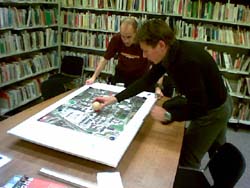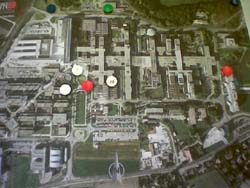Posted: March 31st, 2004 | Comments Off
Premier article écrit avec Nicolas Nova, Patrick Jermann et Pierre Dillenbourg:
Un système de localisation par triangulation pour les activités coopératives
Résumé: Cet article décrit un système de localisation de personnes en environnement construit sur assistant personnel et Pc tablette utilisant un réseau sans fil et la triangulation par rapport à la position des antennes de ce même réseau. Un tel système vise à être employé dans deux contextes. Le premier concerne l’étude de la coordination spatiale d’un groupe dans le cadre d’une tâche semi-écologique. Le second vise à étudier la topologie des espaces d’interactions sociales.
Posted: March 31st, 2004 | Comments Off
A few notes from the presentation of the analysis done by Guillermo Fernandez Castellanos (Professor Matthias Grossglauser) of the User Mobility on the EPFL wireless network. He built an analysis tool (BEGO) of WiFi access points’ logs in order to understand the roaming patterns and propose new roaming models. Data where collected only from the INF building.
2 types of WiFi networks:
- clients build an ad-hoc network
- infrastructure with access points
3 types of mobile users:
- Static user (connects always from the same place)
- Pseudo-mobile user (connects from different places, but disconnects while moving)
- Mobile users (moves while connected)
There where virtually no mobile users detected. The “mobile” population splits more or less in two halves between static and pseudo-mobile users. The heaviest wireless use are at the cafeteria and in the computer room. The average highest simultaneous use of access points is by 4 users. Over 9 monthes, 50% of people connected to 4 APs and 75% connected to only 5 APs. 25% of the people used the wireless network for 1 day over 9 monthes and 66% only 5 days.
The EPFL wireless network is formed by wireless islands.
It is difficult to analyse roaming from AP logs because it seems like they are either badly installed and/or have a bad implementation of the roaming algorithm. In most cases, roaming does not mean mobility.
A factor for mobility could be: (number of access points)/(number of sessions). The higher the more mobile.
Posted: March 27th, 2004 | No Comments »
A study by Richard Florida of the creative class in Europe is out: “Europe in the Creative Age [PDF]“. Too bad it does not take into account non-EU members like Switzerland (and Norway). Indexes for the EU members and the US are calculated based on the 3Ts (Talent, Technology and Tolerance) and put all together to create a Creativity Index, Creativy Trend Index (evolution from the past to the future) and a Creativity Matrix (How a country scores on the creativity index and its recent performance or trend).
This study confirms that the epicenter of competitiveness in Europe is shifting from the traditional powers, especially France, Germany and the United Kingdom, to a cluster of Scandinavian, Nordic and northern European counties. The ability to attract the best and the brightest won’t probably be at the United States advange in the future since number of countries in Europe and elsewhere (notably Canada and Australia) have liberalized their immigration policies and increased their efforts to attract and retain talent. But it also lies in the fact that the climate for creative talent in the United States has chilled somewhat both as a result of direct policies which restrict scientific information and make it harder for people to get into and out of the country and also because of a widening perception of the U.S. as unilaterally aggressive and less friendly toward foreign-born people.
Read the rest of this entry »
Posted: March 26th, 2004 | No Comments »
Friday morning brainstorm on spatial positionning with Pierre and Nicolas. Hard to determine the joint activity on the first picture. The second could be the landing area of the UFOs already witnessed in Geneva this week.


Posted: March 25th, 2004 | No Comments »
J’arrive devant Fabien Barthez sur Google en tapant “fabien”. (16ème sur 621,000) et devant les Beatles (The Fab 4) en tapant “fab” (40ème sur 1,590,000). Yeah!
Posted: March 25th, 2004 | 1 Comment »
Craigslist is one of these things that makes the SF Bay Area so special to live in. Craigslist is an old but very fine (with its daily geniuses and assholes) community web site. The best of Craigslist is online. We are talking about creativity here: “Toilet Bowl Brush – $4″ to “SALE: A singing refrigerator” and “Ever witnessed a UFO or Alien Abduction?”.
Posted: March 24th, 2004 | No Comments »
Via the Internet Scout Project: Pet owners traditionally develop an emotional bond with their pets. However, in this unusual study from the University of Washington, researchers attempted to ascertain whether similar feelings can be evoked from Sony’s robotic dog AIBO. The results indicated that people tend to associate social characteristics to AIBO but not moral characteristics. Four papers related to the study can be downloaded from this website.
Posted: March 24th, 2004 | No Comments »
Toward a Global “Internet of Things is a good intruduction to RFID (Radio Frequency Identification), what is it, a technical description, its uses, its future and connection with Java.
Posted: March 24th, 2004 | No Comments »
Via JJ’s Blog (always intriguing and cool content!), the Computer Science department of the University of Geneva has developed a server/client application that generates so-called true random numbers usign a quantum random number generator) to be used for simulations.
Posted: March 24th, 2004 | No Comments »
Course notes for my Human-Computer Interaction (HCI) course at the EPFL:
Cognitive science: study of how the mind works. Human behaviors.
Information process model (Card): This model consits of three interacting systems. The perceptual (seeing, touching, and hearing), motor (movement of body parts) and cognitive system (The main reasoning relying on facts and knowledge. Acts as processor).
Mental Models:
People have mental models of how things work. It allows them to make predictions on how things work.
A mental model missmatch appears when psychological variables differ from physical ones.
The designer model is the designer’s mental model on how the system should function
The user’s model is the user’s mental model of how their tasks should be accomplished.
The system image is what has been built (how the designer communicates with the user).
The gulf of execution is the distance between user’s goals and the means of achieving them through the system (unintended system image)
A design has to find a good balance between default values and personalization.
Read the rest of this entry »



